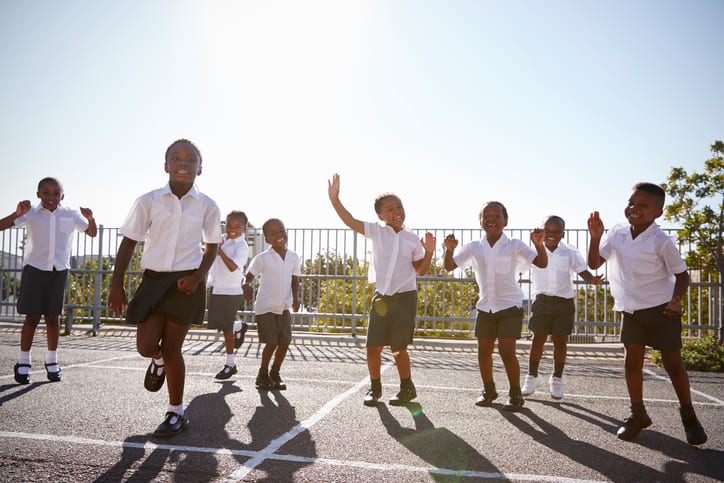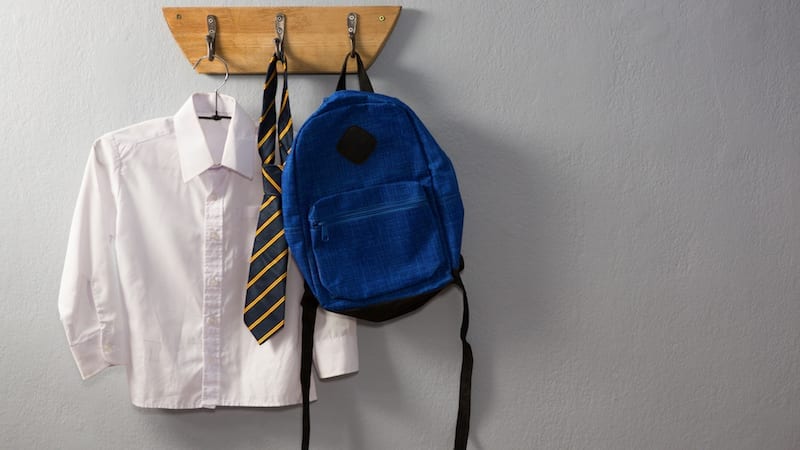School uniforms can be divisive—you either love them or hate them. But as with any complicated issue, there are many pluses and minuses to consider. Wondering whether your school should adopt a school uniform policy? We checked in with school leaders around the country to hear their take on this topic. Here are four pros and four cons of having a school uniform policy.
Pro: Uniforms inspire appropriate behavior.
School uniforms are more than just clothes—they also help keep students focused and on task in the classroom, argues Angi Jones, principal at St. Mary Catholic School in East Dubuque, Illinois. St. Mary requires students to wear uniforms every day except for the last Friday of each month. Jones says there is a noticeable difference in students’ behavior on free-dress days. “On those out-of-uniform days, behavior problems increase, and teasing, bullying, etc. are worse,” she says.
The school keeps the uniform-free days because teachers also get to dress more casually on those days, which they enjoy. Jones says she believes uniforms remind students to be on their best behavior. “Uniforms are more formal,” she says. “When someone is dressed more formally, they use their best manners.”
Con: Uniforms don’t allow students to think critically about their choices.
Instead of giving students a set of guidelines to follow, which requires them to think critically about their choices, uniforms merely teach students how to follow rules, argues Anthony Boyer, dean of culture and climate at La Academia Charter School in Lancaster, Pennsylvania. “To me, uniforms do not provide an academic benefit. It simply is another way to exercise control over children, which makes them resent authority. I was this kind of student. I followed rules if there was good reasoning behind them, and if not, I did not follow them (behind teachers’ backs),” he says.
Pro: Uniforms make students easy to identify on field trips.

Uniforms can serve another important purpose: They make students easy to identify during outings and field trips, Jones says. They also create a more cohesive and polished group of students, which can reflect positively on the school. On the other hand, they also tell disgruntled museum-goers exactly whom to call if students are being disruptive. This can be a motivating factor for students to be on their best behavior.
Con: Uniforms are another form of surveillance placed upon students.
Schools already use many surveillance techniques on students, including metal detectors, drug dogs, cameras, random checks for contraband, metal detectors, and drug tests. It is hard to build a culture of trust and responsibility in a school when students are constantly feeling like they aren’t trusted. Uniforms are another way for authority to monitor and dictate students’ choices.
Pro: Uniforms help foster school pride.

Though her school doesn’t have uniforms, Samantha Chizauskie always wore them when she was a student. Chizauskie, who serves as the principal of Foxboro Elementary School in Vacaville, California, says uniforms help create a sense of belonging. “There is solidarity in wearing uniforms,” she says. “It’s like having spirit day every day.” When students feel connected and there is a sense of community, engagement naturally increases.
Con: School uniforms can potentially alienate students from low-income backgrounds.
Some school uniforms can highlight income differences among students, says Tari Hardy, principal at Sanders Middle School in Sanders, Arizona. Hardy says she became anti-uniform while teaching at another district, some 15 years ago. “They had uniforms, and you could identify the poor kids from a mile away,” she says. “Their uniforms were never as fresh, never as well fitting as the more affluent students’. It was really hard on their parents to buy different clothes for school and for home.”
On the other hand, some schools try to sidestep this issue by offering scholarships to low-income families or by requiring families to purchase school-issued uniforms so that logos and name brands aren’t an issue.
Pro: Uniforms can make life easier for parents.
Parents at Evelyn Stuckey Elementary School in Las Vegas, Nevada, got to vote on whether they wanted students to wear uniforms at the school. The results of the survey showed that the parents seem to love them, says principal Joelle Mills. “Feedback from our community has always been that [parents] like the ease of shopping and getting kids ready in the morning,” she says. The majority of people take between 11 and 30 minutes to get ready every morning. School uniforms help to dramatically cut down this time for students as well as parents who help younger kids get dressed.
Con: School uniforms don’t allow students to express themselves fully.
Principal Hardy remembers how special she used to feel when her mom made her a new piece of clothing to wear to school. “[It was] something that nobody else had,” she said. Uniforms have the potential to inhibit some students’ creativity and self-expression, Hardy argues. “It is important for young people to be able to express themselves, and some do it best through their clothing,” she said. “As an educator, I detest the thought of a student missing class because they were dress-coded. I don’t care if they want to wear a bikini to school. I just want them happy, feeling special, and in class learning all the cool stuff we are teaching.”
Whether you are for or against school uniforms, it seems there are many good arguments on both sides of the issue. Does your school have a uniform policy? If not, do you wish it did?
Join the great conversations going on about school leadership in our Facebook groups at Principal Life and High School Principal Life.
Plus, check out this article on student-centered discipline ideas.

